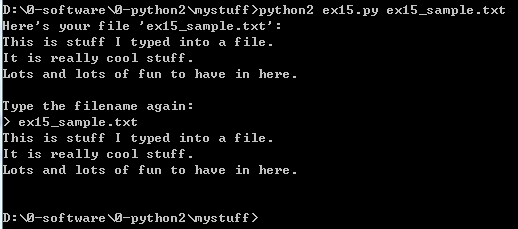笨办法学Python(十五)
习题 15: 读取文件
你已经学过了 raw_input 和 argv,这些是你开始学习读取文件的必备基础。你可能需要多多实验才能明白它的工作原理,所以你要细心做练习,并且仔细检查结果。处理文件需要非常仔细,如果不仔细的话,你可能会吧有用的文件弄坏或者清空。导致前功尽弃。
这节练习涉及到写两个文件。一个正常的 ex15.py 文件,另外一个是 ex15_sample.txt,第二个文件并不是脚本,而是供你的脚本读取的文本文件。以下是后者的内容:
1 This is stuff I typed into a file. 2 It is really cool stuff. 3 Lots and lots of fun to have in here.
我们要做的是把该文件用我们的脚本“打开(open)”,然后打印出来。然而把文件名ex15_sample.txt 写死(hardcode)在代码中不是一个好主意,这些信息应该是用户输入的才对。如果我们碰到其他文件要处理,写死的文件名就会给你带来麻烦了。我们的解决方案是使用 argv 和 raw_input 来从用户获取信息,从而知道哪些文件该被处理。

1 from sys import argv 2 3 script, filename = argv 4 5 txt = open(filename) 6 7 print "Here's your file %r:" % filename 8 print txt.read() 9 10 print "Type the filename again:" 11 file_again = raw_input("> ") 12 13 txt_again = open(file_again) 14 15 print txt_again.read()
这个脚本中有一些新奇的玩意,我们来快速地过一遍:
代码的 1-3 行使用 argv 来获取文件名,这个你应该已经熟悉了。接下来第 5 行我们看到 open 这个新命令。现在请在命令行运行 pydocopen 来读读它的说明。你可以看到它和你自己的脚本、或者 raw_input 命令类似,它会接受一个参数,并且返回一个值,你可以将这个值赋予一个变量。这就是你打开文件的过程。
第 7 行我们打印了一小行,但在第 8 行我们看到了新奇的东西。我们在 txt 上调用了一个函数。你从 open 获得的东西是一个 file (文件),文件本身也支持一些命令。它接受命令的方式是使用句点 . (英文称作 dot 或者 period),紧跟着你的命令,然后是类似 open 和 raw_input 一样的参数。不同点是:当你说 txt.read 时,你的意思其实是:“嘿 txt!执行你的 read 命令,无需任何参数!”
脚本剩下的部分基本差不多,不过我就把剩下的分析作为加分习题留给你自己了。
你应该看到的结果
我的脚本叫 “ex15_sample.txt”,以下是执行结果:

加分习题
这节的难度跨越有点大,所以你要尽量做好这节加分习题,然后再继续后面的章节。
1. 在每一行的上面用注解说明这一行的用途。
2. 如果你不确定答案,就问别人,或者上网搜索。大部分时候,只要搜索 “python” 加上你要搜的东西就能得到你要的答案。比如搜索一下“python open”。
3. 我使用了“命令”这个词,不过实际上它们的名字是“函数(function)”和“方法(method)。上网搜索一下这两者的意义和区别。看不明白也没关系,迷失在别的程序员的知识海洋里是很正常的一件事情。
4. 删掉 10-15 行使用到 raw_input 的部分,再运行一遍脚本。
5. 只是用 raw_input 写这个脚本,想想那种得到文件名称的方法更好,以及为什么。
6. 运行 pydoc file 向下滚动直到看见 read() 命令(函数/方法)。看到很多别的命令了吧,你可以找几条试试看。不需要看那些包含 __ (两个下划线)的命令,这些只是垃圾而已。
7. 再次运行 python 在命令行下使用 open 打开一个文件,这种 open 和 read 的方法也值得你一学。
8. 让你的脚本针对 txt and txt_again 变量执行一下 close() ,处理完文件后你需要将其关闭,这是很重要的一点。
习题练习
1.
1 from sys import argv #导入参数变量模组 2 3 script, filename = argv #设两个参数 script 和 filename 4 5 txt = open(filename) #用 open 函数接收文件名参数,并返回一个值,此处把返回值赋予了 txt 变量 6 7 print "Here's your file %r:" % filename #打印 8 print txt.read() #打印读取的文本内容 9 10 print "Type the filename again:" #打印 11 file_again = raw_input("> ") #把输入值赋予 file_again 变量 12 13 txt_again = open(file_again) #用 open 命令返回文件对象操作值,此处把返回值赋予了 txt_again 14 15 print txt_again.read() #打印读取的文本内容
2.
open 函数的使用:http://www.jb51.net/article/80302.htm
官方文档描述:

1 open(name[, mode[, buffering]]) 2 Open a file, returning an object of the file type described in section File Objects. If the file cannot be opened, IOError is raised. When opening a file, it’s preferable to use open() instead of invoking the file constructor directly. 3 4 The first two arguments are the same as for stdio‘s fopen(): name is the file name to be opened, and mode is a string indicating how the file is to be opened. 5 6 The most commonly-used values of mode are 'r' for reading, 'w' for writing (truncating the file if it already exists), and 'a' for appending (which on some Unix systems means that all writes append to the end of the file regardless of the current seek position). If mode is omitted, it defaults to 'r'. The default is to use text mode, which may convert '\n' characters to a platform-specific representation on writing and back on reading. Thus, when opening a binary file, you should append 'b' to the mode value to open the file in binary mode, which will improve portability. (Appending 'b' is useful even on systems that don’t treat binary and text files differently, where it serves as documentation.) See below for more possible values of mode. 7 8 The optional buffering argument specifies the file’s desired buffer size: 0 means unbuffered, 1 means line buffered, any other positive value means use a buffer of (approximately) that size (in bytes). A negative buffering means to use the system default, which is usually line buffered for tty devices and fully buffered for other files. If omitted, the system default is used. [2] 9 10 Modes 'r+', 'w+' and 'a+' open the file for updating (reading and writing); note that 'w+' truncates the file. Append 'b' to the mode to open the file in binary mode, on systems that differentiate between binary and text files; on systems that don’t have this distinction, adding the 'b' has no effect. 11 12 In addition to the standard fopen() values mode may be 'U' or 'rU'. Python is usually built with universal newlines support; supplying 'U' opens the file as a text file, but lines may be terminated by any of the following: the Unix end-of-line convention '\n', the Macintosh convention '\r', or the Windows convention '\r\n'. All of these external representations are seen as '\n' by the Python program. If Python is built without universal newlines support a mode with 'U' is the same as normal text mode. Note that file objects so opened also have an attribute called newlines which has a value of None (if no newlines have yet been seen), '\n', '\r', '\r\n', or a tuple containing all the newline types seen. 13 14 Python enforces that the mode, after stripping 'U', begins with 'r', 'w' or 'a'. 15 16 Python provides many file handling modules including fileinput, os, os.path, tempfile, and shutil. 17 18 Changed in version 2.5: Restriction on first letter of mode string introduced.
7.

可以看出 open 函数的返回值是十六进制表示的正整数



